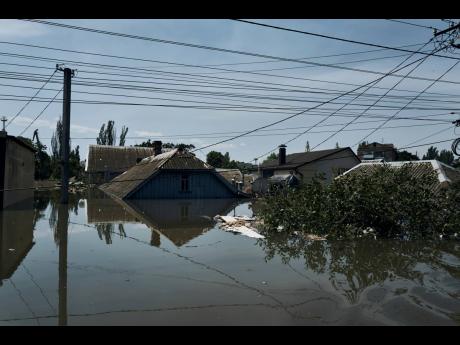Authorities rush to rescue hundreds stranded on rooftops
KHERSON (AP):
The authorities rushed to rescue hundreds of people stranded on rooftops and supply drinking water to areas flooded by a collapsed dam in southern Ukraine on Wednesday, in a growing humanitarian and ecological disaster along a river that forms part of the frontline in the 15-month war.
The collapse of the Kakhovka hydroelectric dam and emptying of its reservoir on the Dnieper River added to the misery the region has suffered for more than a year from artillery and missile attacks.
With humanitarian and ecological disasters still unfolding, it’s already clear that tens of thousands of people have been deprived of drinking water, many are homeless, crops are ruined, land mines have been displaced, and the stage is set for long-term electricity shortages.
Some residents of Russia-occupied areas hit by high water complained that help was slow in arriving, with some stranded on roofs and streets passable only by boat in scenes more like natural disasters than wars. Others refused to leave.
The first report of casualties from the disaster emerged, with a mayor reporting three dead. At least 4,000 people have been evacuated from both the Russian and Ukrainian-controlled sides of the river, officials said, with the true scale of the disaster yet to emerge in an affected area that was home to more than 60,000 people. Russia-appointed authorities in the occupied parts of the Kherson region reported 15,000 flooded homes.
The dam and reservoir, essential for fresh water and irrigation for southern Ukraine, lies in the Kherson region that Moscow illegally annexed in September and has occupied for the past year. The reservoir is also critical for water supplies to the Crimean Peninsula, which Russia illegally annexed in 2014.
Ukraine holds the Dnieper’s western bank, while Russia controls the low-lying eastern side, which is more vulnerable to flooding.
The high water could wash away this season’s crops, while the depleted Kakhovka reservoir would deny adequate irrigation for years. The reservoir’s loss also complicates any efforts to rebuild and restart the destroyed hydroelectric power station and ensure cooling water for any future attempts to restart the shut-down Zaporizhzhia Nuclear Power Plant.
A day after the dam’s collapse, the cause remained unclear, with both sides blaming each other. Some experts cited wartime damage and neglect, although others argued that Russia might have destroyed it for military reasons. Either way, concluded analyst Michael Kofman, “Russia is responsible, either by virtue of action or by virtue of the fact that it controlled the dam.”
“It’s going to lead to lasting damage to agriculture, provision of drinkable water. And it’s going to wipe out entire communities,” Kofman – who is with the Center for Naval Analyses, a US research group – told PBS NewsHour.
Many residents had fled the region because of the fighting, but clear estimates of those remaining weren’t available.
Ukrainian President Volodymyr Zelenskyy met with officials on how to provide drinking water to residents, as well as assess damage to wetlands, farms and other property from what he called “a crime of ecocide” and “a man-made strike on the environment, after which nature will have to recover for decades”.

